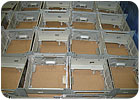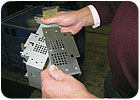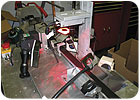
Buhrke Industries uses a vision sensor to inspect these car radio chassis. The sensor determines whether a plastic nut has been inserted correctly.
One reason for our success is our commitment to exploring new technologies for improving efficiency. As part of that commitment, we are increasingly using low-cost vision sensors to ensure our products meet the demanding quality standards of the automotive industry.
As Buhrke’s process engineer, I first became interested in vision sensors about 5 years ago, when a customer discovered a weld nut missing from one part in a run of about 700,000 assemblies. We needed a way to check that the two weld nuts on the part were present, welded correctly and within our height tolerance. After looking into a couple of options, we chose the PresencePLUS Pro vision sensor from Banner Engineering Corp. (Minneapolis). We use the sensor to check and measure the parts as they pass by on a conveyor. Suspect parts are diverted to a reject bin. We had attended a couple of vision seminars by Banner vision representatives, and we were able to dial in the application with their help.
The cost of the vision sensor is offset by not needing personnel to sort through the parts manually. More importantly, the sensor prevents us from getting a black mark when a customer finds a bad part, instead of us.

On an automated line for assembling radio chassis, Buhrke engineers encountered a problem with the insertion of heat sinks. Parts were occasionally damaged due to inconsistent positioning of the parts. A hastily installed vision sensor prevented faulty assemblies from reaching the customer while engineers worked to solve the problem.
Finding More Uses for Vision
Our initial success with vision sensors encouraged us to experiment with using them to improve quality control in our other production lines. Because our annual volumes run into the millions, it was essential to incorporate part measurement and part presence verification into our production lines.Among our customers is Siemens VDO, an international supplier of automotive electronics and mechatronics. For Siemens, we manufacture a dozen different brackets used in systems that monitor tire pressure. The production line for the brackets includes a welding station, where two operators at four machines weld studs onto each part. After welding the studs, the operator sets the bracket on a conveyor. The conveyor passes the parts below a high-resolution PresencePLUS vision sensor, which checks the position of each stud. The inspection requirements for each bracket model are stored in the sensor’s memory. My team devised a simple switched lockbox for changing the program: An authorized worker inserts and turns the key, presses the button for the correct bracket, and then turns the key again to load the program.
We use the same model of vision sensor on a line that manufactures a radio and CD player chassis for Siemens. This time, the sensor monitors the insertion of a plastic nut. Because the nut establishes the correct location of the radio when it’s installed in the dashboard, the nut must be fully threaded into the chassis bracket. The sensor takes measurements while the part is on the conveyor to verify that the nut is within 0.005 inch of our specification. Chassis with nuts that are not fully threaded are automatically rejected.
As we’ve become accustomed to using vision sensors for quality control, we’ve found ways to use them for short-term needs. For example, on an automated assembly line for a radio chassis, we encountered a problem during placement of a heat sink. Parts were occasionally being damaged due to inconsistent positioning of the parts. Using a magnetic mount, we quickly installed a PresencePLUS vision sensor to keep an eye on the process. The sensor was hooked up to a small monitor that the operator watched as he cycled the machine. The images enabled us to immediately identify faulty parts. We have since corrected the chassis problem, but adding the camera let us continue production uninterrupted.
All these inspections use the same method to prevent a rejected part from being mixed in with good parts. First, we follow a single-part flow scheme, which limits the number of parts moving between workstations. As the name suggests, single-part flow means that only one part is waiting to be processed at any workstation. For example, if the accumulation tray shows more than three parts at a station, the preceding station is locked out until an operator removes the parts. This reduces the risk that an operator will mistakenly think that a step has been completed on a part, which can happen when several parts in progress get backed up at a station. We adopted single-part flow at the request of a customer, and we now incorporate the technique in all our assembly jobs.
Another way we prevent rejects from mixing with good parts is by linking the vision sensor to the machine controller. After each part is assembled, a vision sensor must register whether the part is good or bad, before the operator can cycle the machine again-this step prevents the operator from placing the part where it does not belong. In addition, rejected parts are automatically diverted into a locked containment box to prevent them from accidentally being included with acceptable parts.
We also built a portable vision inspection station on a wheeled cart. For maximum versatility, we equipped the cart with a PresencePLUS P4 OMNI, a full-featured vision sensor that can perform a wide range of inspections. The cart also is also equipped with flexible lighting suited to different applications. The cart lets us do spot checks on any process in the plant.

A portable vision inspection station on a wheeled cart lets engineers conduct spot checks on any process in the plant. The cart is equipped with a full-featured vision sensor that can perform a wide range of inspections.
Eyes on Mexico
Our most recent innovative use of vision sensors is for monitoring our manufacturing lines in Mexico remotely through a T1 Internet connection.At our plant in Frontera, Mexico, we manufacture a nozzle subassembly used in the propellant chamber of an air bag inflator made by Takata Corp. (Tokyo). The subassembly consists of the nozzle, a stainless steel shim, and an adhesive-backed foil. The parts are loaded manually and assembled with a pneumatic press. It’s critical for the parts to be correctly located before they are pressed into place. As a result, the assembly station is equipped with three PresencePLUS P4 vision sensors. Two standard-resolution sensors verify the presence and position of the parts, and one high-resolution sensor checks and records a specific height measurement. The entire inspection takes less than 40 milliseconds per part.
Besides checking the parts on-site, the vision sensors enable me to view inspections remotely in real time. This enables me to track quality and predict problems. I can even adjust or reset the sensors from my desk.

Buhrke manufactures a dozen different brackets used in systems that monitor tire pressure. A single vision sensor inspects all 12 bracket models-only the programming is changed.
The Payback
Our use of vision sensors has helped us prevent system crashes, inspect 100 percent of our parts, and streamline our production processes. Our results have earned Buhrke two awards: the 2005 Siemens VDO Vendor Performance Award, based on a defect rate of 6 parts per million for 10.2 million parts, and Takata’s Quality First Award, based on a defect rate of 3 parts per million for 65 million parts.Serving the automotive market is a demanding business. Companies that serve Tier One suppliers face pressure to reduce costs, deliver orders just in time, and satisfy rigorous quality standards. As a result, we continually fine-tune our operations and constantly search for improvements. To remain competitive, we look for whatever technological advantages we can employ to improve efficiency and maintain the highest level of quality. We will continue to invest in the latest assembly and sensing equipment, because the race to the top will be won by those who are best prepared to meet whatever challenges come their way.